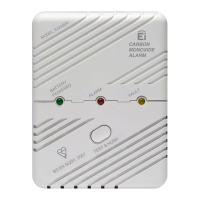
Do you have a question about the Ei Electronics Carbon Monoxide Alarm Ei 204EN and is the answer not in the manual?
| Sensor Type | Electrochemical |
|---|---|
| Alarm Sound Level | 85 dB at 3 meters |
| Test Button | Yes |
| LED Indicator | Yes |
| Operating Temperature | -10°C to +40°C |
| Dimensions | 120mm x 85mm x 40mm |
| Power Source | Battery |
| Battery Life | Up to 5 years |
| Weight | 155g |
| Warranty | 5 years |
| Standards Compliance | EN 50291-1 |
| Battery Type | Lithium |
| Standards | EN 50291-1 |
Explains what Carbon Monoxide is, its chemical symbol, and its toxicity.
Details symptoms of mild, medium, and extreme exposure to CO.
Explains how the CO alarm reacts to different CO levels and exposure times.
Details how the alarm stores and indicates past CO detection events for specific models.
Lists ideal rooms and general principles for placing CO alarms.
Lists areas where CO alarms should not be placed due to potential interference or ineffectiveness.
Specifies placement height and distance from potential CO sources for rooms with appliances.
Guides placement in bedrooms or areas distant from appliances, near breathing level.
Step-by-step guide for powering up and preparing the alarm for installation.
Instructions on how to secure the battery compartment to prevent unauthorized access.
Explains how to connect multiple alarms for simultaneous alarming (Ei205CEN model).
How to test the alarm's functionality using the test button.
Explains the meaning of the green light flashing, indicating operational status.
Describes the beeps and light flashes that indicate low battery status.
Explains the meaning of the amber light flashing, indicating a potential fault.
Describes how to test the alarm using CO gas kits.
Instructions on how to clean the unit's exterior and slots without damaging it.
Explains the signals indicating the unit has reached its end of operational life.
Guidance on how to dispose of the product responsibly, following recycling symbols.
Discusses limitations related to the alarm sound not being heard and the finite lifespan of the device.
Clarifies that alarms are not life insurance or smoke detectors.
Lists tell-tale signs of CO presence and flu-like symptoms in family members.
Provides advice on choosing, installing, and maintaining fuel-burning appliances and vehicles.
Details power source (batteries) and compliance with CO sensitivity standards.
Covers EMC compliance and the function of the test/hush button.
Covers CO testing, initialisation time, operating temperature, and humidity range.
Details audible alarm levels, self-diagnostic features, and CO alarm memory function.
Instructions for returning a faulty alarm for repair or replacement.
Specifies the conditions under which the guarantees are valid and exclusions.
Provides steps to resolve issues when the alarm fails the test button.
Addresses the issue of the alarm beeping every 45 seconds, indicating battery or fault.
Guides on troubleshooting when the alarm sounds without an obvious cause.
Explains the normal 'all lights flash' and 'amber light flashing' indicators.
